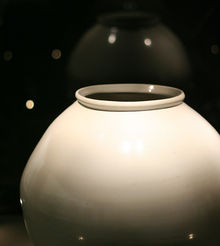- Moon jar
-
Moon jar 
Korean name Hangul 달항아리 / 백자대호 Hanja none / 白磁大壺 Revised Romanization dal hangari / baekja daeho McCune–Reischauer tal hanari /paekcha taeho Moon jar is a type of traditional Korean white porcelain which was made during the late 17th through 18th century, the late period of the Joseon Dynasty (1392-1910). The name comes from its shape and milky color of the glaze to remind of full moon. It has inspired many artists such as Kim Whanki and Bernard Leach.[1][2][3][4]
See also
References
- ^ J. Portal. "White porcelain 'moon jar'". British Museum. http://www.britishmuseum.org/explore/highlights/highlight_objects/asia/w/white_porcelain_moon_jar.aspx.
- ^ Seo Dong-shin. "White Moons Rise on Chosun Porcelains". artseoul.net. http://www.artseoul.net/artnews/news06/e0717koobohnchang.html.
- ^ "백자달항아리" (in Korean). Doosan Encyclopedia. http://www.encyber.com/search_w/ctdetail.php?masterno=482279&contentno=482279.
- ^ Noh Hyeong-seok (노형석) (2005-08-17). "묵향속의 우리 문화유산 - (29) 백자 달 항아리" (in Korean). The Hankyoreh. http://www.hani.co.kr/kisa/section-005001000/2005/08/005001000200508171839560.html.

This ceramic art and design-related article is a stub. You can help Wikipedia by expanding it.
